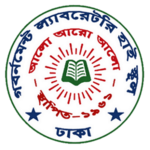Government Laboratory High School
| Government Laboratory High School, Dhaka | |
|---|---|
 |
|
| Location | |
|
1 Naem Road, Dhanmondi Mirpur Road Dhaka 1205 Bangladesh |
|
| Coordinates | 23°44′9.97″N 90°22′54.15″E / 23.7361028°N 90.3817083°ECoordinates: 23°44′9.97″N 90°22′54.15″E / 23.7361028°N 90.3817083°E |
| Information | |
| Type | Public boys school |
| Motto |
Latin: Alo aro alo {Light, more light (with knowledge)}, Come for knowledge, go out for help |
| Established | 3 September 1961 |
| School district | Dhaka |
| Grades | 1-12 |
| Campus type | Urban |
| Color(s) | White and Navy Blue |
| Nickname | Laboratorians, Lab, G. Lab |
| Accreditation | Board of Intermediate and Secondary Education, Dhaka |
| Yearbook | Anushilon |
Latin: Alo aro alo {Light, more light (with knowledge)},
The Government Laboratory High School (Govt. Lab.) is a school located in Dhanmondi, Dhaka, Bangladesh. The school was established on 3 September 1961.
The principal of the adjacent Teacher's Training College, Muhammad Osman Gani, sought to establish a facility to assist his trainees practice teaching. From this idea, Government Laboratory High School was created. The school was inaugurated in 1961 by the then Director of the Department of Public Instruction (D.P.I), Muhammad Shamsul Haque. The first headmaster was Khan Muhammad Salek, who went on to serve for 12 years. Below is a list of the first teachers at the school, upon its opening.
The Directorate General of Secondary and Higher Education, Dhaka, divides the city's government schools into three groups: A, B, and C. Government Laboratory High School is in group A. Candidates may apply to multiple schools, but to no more than one in each group. Admission to class 1 is by lottery. Admission tests for classes 2 through 8 are administered in mid-December. Admission to class 9 depends on Junior School Certificate (JSC) or Junior Dakhil Certificate (JDC) results.
During initial planning it was envisaged that study would start from class 3. However, due to eagerness from both Muhammad Osman Gani and Khan Muhammad Salek, classes 1 and 2 were included. Class 8 was the highest offered during the first academic year (1961–62). Class 9 was added the following year, and class 10 the year after that, so the school's first Secondary School Certificate examinations took place in 1964.
Classes are usually divided into four sections, 'A', 'B', 'C' and 'D', containing 60 students each. The students' day is split into two shifts, 'Morning' and 'Day', with two sections studying in each half of the day.
In 2007, due to more the admittance of a greater number of meritorious students than there were allotted seats, this system was extended in class 1. This included two extra sections, 'E' and 'F' and three sections studying during each shift.
The students are grouped into four houses for participation in competitions. The houses are named after four legends which each represent a human quality: Al Biruni (scholarship), Al Ma'mun (good governance), Omar Khayam (youth) and Salahuddin (bravery). Each house has a colour; yellow, blue, green and red respectively.
...
Wikipedia
